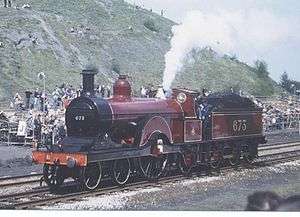Midland Railway 115 Class
| Midland Railway 115 Class | |||||||||||||||||||||||||||||||||||||
|---|---|---|---|---|---|---|---|---|---|---|---|---|---|---|---|---|---|---|---|---|---|---|---|---|---|---|---|---|---|---|---|---|---|---|---|---|---|
 No. 673 at the Rainhill Trials 150th anniversary cavalcade in 1980 | |||||||||||||||||||||||||||||||||||||
| |||||||||||||||||||||||||||||||||||||
| |||||||||||||||||||||||||||||||||||||
| |||||||||||||||||||||||||||||||||||||
| |||||||||||||||||||||||||||||||||||||
The Midland Railway 115 Class is a class of 4-2-2 steam locomotive, nicknamed "Spinners". They were designed by Samuel W. Johnson and a total of 15 of the class were built between 1896 and 1899.
Construction history
The fifteen locomotives in the class were built in two batches, both at Derby Works.
| Original No. | 1907 (& LMS) No. | Derby Works Order No. | Year | Notes |
|---|---|---|---|---|
| 115–119 | 670–674 | 1474 | 1896–97 | |
| 120, 121, 123–128, 130, 131 | 675–684 | 1659 | 1899 |
Service history
It was quite common for this class of engine to pull a typical Midland express weighing 200 and 250 long tons (203 and 254 t; 224 and 280 short tons) which suited the Class 115 perfectly. Given a dry rail they could maintain a tight schedule with 350 long tons (356 t; 392 short tons). Speeds up to 90 mph were not uncommon and the sight of their whirring huge driving wheels earned them the nickname "Spinners". Thanks to the Midland's practice of building low powered locomotives and relying on double-heading to cope with heavier trains many enjoyed working lives of up to 30 years. They made ideal pilot engines for the later Johnson/Deeley 4-4-0 classes.
Renumbering
In the Midland Railway 1907 renumbering scheme, they were assigned numbers 670–684. During World War I most were placed in store but, surprisingly, pressed into service afterwards as pilots on the Nottingham to London coal trains. Twelve locomotives survived to the 1923 grouping, keeping their Midland Railway numbers in London, Midland and Scottish Railway (LMS) service. Nevertheless, by 1927 only three of the class remained, with the last engine, 673 (formerly 118) being withdrawn in 1928 and preserved.
| Year | Quantity in service at start of year | Quantity withdrawn | Locomotive numbers | Notes |
|---|---|---|---|---|
| 1921 | 15 | 2 | 675, 684 | |
| 1922 | 13 | 1 | 681 | |
| 1925 | 12 | 2 | 674, 676 | |
| 1926 | 10 | 8 | 670–672, 677, 678, 680, 682, 683 | |
| 1928 | 2 | 2 | 673, 679 |
Preservation
No. 673 is the sole survivor of its class. It was steamed around 1976–1980 when it took part in the Rainhill Trials 150th cavalcade but is currently a static exhibit in the National Railway Museum in York.
References
| Wikimedia Commons has media related to Midland Railway 115 Class. |
- 1 2 Essery & Jenkinson 1988, p. 170.
- 1 2 Baxter 1982, pp. 134–135.
- Baxter, Bertram (1982). Baxter, David, ed. British Locomotive Catalogue 1825–1923, Volume 3A: Midland Railway and its constituent companies. Ashbourne, Derbyshire: Moorland Publishing Company.
- Classic British steam Locomotives
- Casserley, H.C.; Johnston, Stuart W. (1974) [1966]. Locomotives at the Grouping 3: London, Midland and Scottish. Shepperton, Surrey: Ian Allan. ISBN 0-7110-0554-0.
- Essery, R. J & Jenkinson, D. (1988). An Illustrated Review of Midland Locomotives, Volume 2: Passenger tender classes. Didcot: Wild Swan Publications. ISBN 0 906867 59 2.